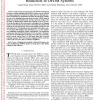Free Online Productivity Tools
i2Speak
i2Symbol
i2OCR
iTex2Img
iWeb2Print
iWeb2Shot
i2Type
iPdf2Split
iPdf2Merge
i2Bopomofo
i2Arabic
i2Style
i2Image
i2PDF
iLatex2Rtf
Sci2ools
TSP
2008
2008
Clipping-Noise Guided Sign-Selection for PAR Reduction in OFDM Systems
The peak-to-average power ratio (PAR) of orthogonal frequency division multiplexing (OFDM) systems can be reduced by using an optimal set of subcarrier signs. However, this sign selection is a hard discrete optimization problem. We therefore consider the use of the clipping noise, generated when the OFDM signal is clipped at a given threshold level, to find a good set of signs. The key idea of clipping-noise guided sign-selection (CGS) is to iteratively flip the signs of those subcarriers with high levels of clipping noise. In each iteration, the key task is to determine the number and locations of such subcarriers. We develop suitable criteria for this task and derive CGS algorithms that can handle both unitary (e.g., M-ary phase shift keying) and nonunitary (e.g., M-ary quadrature amplitude modulation) signal constellations. The simulation results show that the PAR reduction of CGS is about 1 dB larger than that of derandomization and tone reservation for a 256-subcarrier system, and...
| Added | 16 Dec 2010 |
| Updated | 16 Dec 2010 |
| Type | Journal |
| Year | 2008 |
| Where | TSP |
| Authors | Luqing Wang, Chintha Tellambura |
Comments (0)

